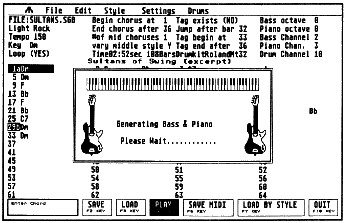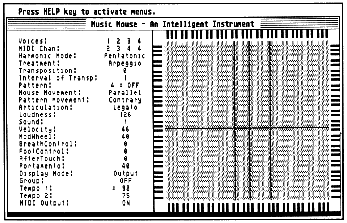REFLECTIONS
BY JIM PIERSON-PERRY
I'm writing this column during the February doldrums - just after the winter NAMM show and prior to a major international music trade show in Germany this March. With new software/hardware products and true multitasking environment coming quickly toward us, it seems appropriate for a quick retrospective of last year's hopes and realities, as well as our usual potpourri of new releases and notes.
Progress and Promise
This installment marks the twelfth appearance of the "ST/MIDI Connection,"
an anniversary of sorts. Back in the January 1989 issue, I fantasized about
software applications that I would like to see explored. The categories
were: scoring music to video (hit list management), sample resynthesis,
new forms of algorithmic composing (especially for real-time interaction!
improvisation), intelligent scoring, drum machine programming and a standard
multitasking environment.
How have we done since then? Not too badly. Hitman and Hitlist are software solutions for scoring to video, while more advanced users have the ADAP II digital sound workstation. The Avalon sample editor includes a fair start at frequency domain sample editing and resynthesis. MIDI Drummer II, as well as numerous sequencers, provides convenient drum-machine programming solutions. Finally, after several developers created their own versions, Atari has selected the MIDI-Tasking multi-application manager from Intelligent Music as their standard. Some new algorithmic composing efforts have come out while new ones lurk in the wings -call this one a draw on prediction. The only clear miss was scoring, where the year saw little activity (particularly relative to exciting new Macintosh software).

Sample composition screen
from Band In A Box, the
new algorithmic composition
program to create piano,
bass and drum accompaniment
parts for songs.
OK, bucko, what's next? Here is my condensed wish list for the coming months. First, Atari must work diligently to integrate its newly sanctioned multitasking environment with major software developers across all product applications. While MIDI-to-MIDI communication is paramount, there is no reason why not to be running a sequencer along with a word processor while being on-line to a BBS. Developers, on the other hand, need to move away from the "Total Workstation" program concept and use smaller, robust modules for individual needs. Massive efforts combining patch editors, scoring, sequencing, etc. into one program are simply too unwieldy. Rather than do a single task well, many are done with numerous compromises. This is where multitasking is vital for interprogram communication. Users benefit from faster learning curves, less resource requirements (only use the parts you need) and easy customization of software systems.
General application areas that need a boost are home music education (theory, performance, critical listening, etc.) and sample editing. The latter will require some form of hardware assist, such as in the new Sound Tools package, for speed and audio quality. A potential sleeper is the canned sequence market, should average home owners begin to discover low cost synth modules as the "next" piece of a stereo system. These sequence libraries (already being marketed by Passport Design and others) are also a Godsend to musicians on gigs without the time to craft their own.

Playing screen for MIDI
Mouse, the software performance
instrument by Laurie
Spiegel.
My last bet is that MIDI dataprocessing programs will become far more valuable as musicians learn how to use them. These programs are the offspring of the computer/MIDI union; new software instruments with capabilities that can't be duplicated by unaugmented human musicians.
New Releases
One of the neatest programs I've seen in a long time is Band In
A Box, released for the Atari and IBM by PG Music. You type in the
chords to a song and the program uses algorithmic composing to derive accompanying
piano, bass and drum parts. The fun comes in with a style-selection menu
that determines which algorithms will be applied. These range from polka,
through country to hard rock - 14 choices in all. Band In A Box plays the
accompanying parts through MIDI while you jam along and saves its parts
in MIDI file format 1 to import into a sequencer program for later tweaking.
The quality of the accompaniments is quite good. Fifty song files of all
styles are included with the program; an additional 250 song files are
available on a MIDI Fake Book. Plans for a future upgrade are to add additional
voices for horns and strings.
A different beast altogether is Scorpion Systems' sYbil, a real-time MIDI data processor along the lines of MidiMax and Ultra MIDI. You can use it to control multiple synths or other devices from a single controller, with each responding in a different fashion as you play. Keyboard splits, layers and zoning are snaps to set up and change between notes. Even the ST keyboard can be used as a controller - playing MIDI music and effects by touch typing. To get a better idea of sYbil's potential, you can call a demo hot line at (313) 827-1444.
MIDImouse has released Music Lights, an interactive computer graphics link to your home MIDI system. It plays standard MIDI files (format 0) and accompanies them with expressive graphics displays. Ten styles of graphics are provided including swirling lines, spirals, kaleidoscope, inkspots and more. Not only does it play MIDI files, you can play into it from a MIDI keyboard or even use the ST keyboard (and save your work into a MIDI file). Don't have a MIDI synth? No problem, Music Lights also works fine just by playing the ST internal speaker -particularly good for demoing the ST sound/graphic abilities. Also announced was Rhythm Time, the fourth title in MIDImouse's educational software series.
MIDI-controlled mixing applications are a fast growing interest. Two new releases hit the opposite poles of the user audience: home hobbyist or semi-pro and high-end pro studio. At the introductory level (really the price only - its capabilities go well into the pro level) is the Audio Control Module from Steinberg/Jones. This eight-channel mixer sports eight ins, eight outs and a stereo mix with full MIDI control of the faders. It is similar to VGA-controlled mixers but uses a different technology and is reported to be very clean and quiet. Each mixer channel is governed by a real-time MIDI controller message on a specific channel. Taken to the limit, you could gang 16 modules together for a total of 128 mixing channels!
At the high end is the VGA-based MAGI II (Mixer Automation Gain Interface), giving SMPTE-locked fader mixing and mute automation for up to 64 faders. Two versions are available: the basic MAGI II (remote unit that connects into your existing console board audio path) and MAGI IIi (a retrofit for existing mixing consoles). Integral to the systems is controlling software (Atari and Mac versions) that provide graphic mix displays, cue list editing and MIDI event generation.
Of course, what month would be complete without new patch editors? This time it's Big Noise Software with selections for the new Korg M3r and T-123 series. These are the first dedicated patch editors for these synths in the Atari market.
Updates
C-Lab is now shipping version 2.2 of its Creator/Notator sequencers
through U.S. distributor Digidesign. A major new feature is the incorporation
of Soft Link Level 2, the C-Lab version of a multi-application manager,
allowing up to eight other Atari applications to run simultaneously with
Creator/Notator (memory permitting). An additional new feature lets you
automatically load/ play a song at a preprogrammed time and apply the velocity
dynamics of one track to another.
Master Tracks Pro version 3.5 is available from Passport Design. This version fixes a TOS 1.4 incompatibility with certain mouse double-click actions and is - deep breath now -not copy protected. Thank you Passport for your vote of confidence!
On the patch editor side, Dr. T has released version 1.1 of X-OR, the first generic patch editor program for the Atari. You can now dump entire patch banks into a patch library, rather than enter them one at a time. Support for multi-timbral synths is greatly improved with automatic tracking of MIDI channel, etc. E-OR, the development program to create new instrument profiles now comes with X-OR. Currently, profiles exist for over 50 instruments - most providing full patch/performance editor support.
Staccato Notes
Good news for those of you with the Atari SLM804 laser printer. The
Laser Brain Epson emulator (available on both GEnie and CompuServe)
has been released into the public domain by Atari. This works well with
scoring programs such as EZ-Score Plus from Hybrid Arts to get output from
the laser. Resolution is not 300 dpi but is considerably crisper. And,
of course, it's faster than going through a dot-matrix ribbon printer.
Anyone with an interest in learning how to program synth patches should make a point to follow Lorenz Rychner's continuing series in Music Technology magazine. Synths described in past issues include the DX7, TX81Z, D110 10, Ml, KI and K4. Another continuing column (on a more sporadic basis) in the same mag is on advanced sampling techniques by guru Chris Meyer. Both are full of information and do-it-yourself exercises.
Dr. T has picked up distribution of Laurie Spiegel's Music Mouse program (formerly handled through Aesthetic Engineering). This is an algorithmic composition program, particularly well suited for live performance.
From the Roundtable
There are a few new additions worth mentioning in the MIDI Roundtable
library of the GEnie BBS. First is SEQUENCR (library program #1045),
a full-fledged 16-track sequencer put into the public domain. This program
runs on all ST/Mega models in either medium or high resolution. I found
only one problem - it looks for its resource file (SEQLJENCR.RSC) only
in drive A. If not found, the program bombs. Just be sure to keep a copy
of the file on a floppy in Drive A and all will be well.
Confused about generic patch editor claims? Try them for yourself with the demo versions of X-OR (#805) and GenEdlt (#988, #989). Another demo worth evaluating is BOSSDEMO (#963, #964), a trial version of the MIDI BOSS system control and real-time mapping program from Johnsware (who also maintains Category 22 in the MIDI Roundtable Message Board, should you have questions).
Finally, those of you with the popular D110 multi-timbral synth may appreciate the XPATD110 patch file conversion program (#984). It accepts patch files in Dr. T, MIDIMouse, Omnibanker, GenPatch and MIDIEX formats and can translate them into Dr. T, MIDIMouse and MIDIEX formats.
PRODUCTS MENTIONED
M3r Patch Editor, $119.95. T-123 Patch Editor, $119.95. Big Noise Software, Inc. P.O. Box 23740, Jacksonville, FL 32241, 904/730-0754.
MIDIMax, $49.95. Codehead Software, P.O. Box 74090, Los Angeles, CA 90004, 21 3/386-5735.
C-Lab Creator, $349. C-Lab Notator, $649. Sound Tools, $2,995. Digidesign, 1 360 Willow Run, Suite 101, Menlo Park, CA 94025, 415/327-8811.
Hitman, $99. Music Mouse, $79.95. X-OR, $ 299. Dr. T's Music Software, 220 Boylston Street, Suite 306, Chestnut Hill, MA 02167, 617/244-6954.
ADAP II, call for price. EZScore Plus, $149.95. GenEdit, $249. Hybrid Arts, Inc., 8522 National Blvd., Culver City, CA 90232, 213/841-0340.
MAGI II, call for price. J. L. Cooper, 1931 Pontius Avenue, West Los Angeles, CA 90025, 213/473-8771.
Music Lights, $49.95. Rhythm Time $69.95. Ultra MIDI, $229.95. Midimouse Music, Box 272-A, Rhododendron, OR 97049, 503/622-4034.
Hitlist, $199.95. MIDI Drummer II, $90. MusicSoft, 30 North Raymond, Suite 505, Pasadena, CA91 103, 818/449-8838.
Master Tracks Pro, $395. Upgrade to version 3.5, $10 with old master disk. Passport Designs, Inc., 625 Miramontes Street, Half Moon Bay, CA 94019, 415/726-0280.
Band In A Box, $59. MIDI Fake Book, $29. PG Music, 266 Elmwood Avenue, Suite 111, Buffalo, NY 14222, 416/528-2368.
sYbil, $299. Scorpion Systems Group, 836 Page, San Francisco, CA 94117, 415/864-2956.
Audio Control Module, $479. Avalon, $349. Steinberg/Jones, 17700 Raymer Street, Suite 1001, Northridge, CA 91325, 818/993-4091.